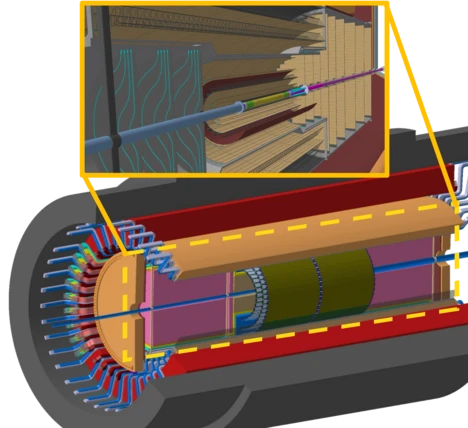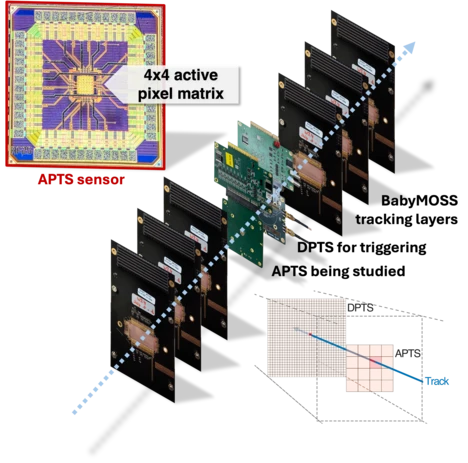ALICE 3 Outer Tracker: The largest CMOS MAPS tracker ever

The ALICE experiment at the LHC in CERN is planning to upgrade its detector systems in the upcoming Long Shutdown 4 of the LHC scheduled for 2034. The new detector system, called ALICE 3, will feature a completely new set of detector systems able to measure at increased collision rates, support a larger forward acceptance, and will be supported with a new 2T superconducting solenoid magnet. One of the main subdetectors, the Outer Tracker, is based on the silicon CMOS MAPS technology and will instrument an unprecedented 60 m2 active area, with layers supporting a spatial resolution of 10 µm2 and a material budget below 1% x/X0. Our group is deeply involved in the R&D effort needed to build this unprecedented detector, led by Prof. Fabbietti as the project leader for ALICE 3 OT.
Further reading:
- ALICE 3 Letter-of-Intent: https://arxiv.org/abs/2211.02491
- ALICE 3 Scoping Document: https://cds.cern.ch/record/2925455?ln=en
Tracker performance simulation studies
For the design of a complex detector such as the Outer Tracker, it is crucial to utilize simulations for assessing the impact of various design choices on the physics performance of the experiment. For this, a simulation pipeline based on the ACTS (A Common Tracking Software) has been built. With this tool, a number of investigations are being carried out to pin down the requirements needed for the detector subsystems to effectively collect data in the intense high-luminosity LHC environment. These include studies on the timing performance of the tracker layers, optimization of the layer positions, and material budget distributions of the trackers, and the development of advanced tracking algorithms needed for seamless reconstruction over the large acceptance of ALICE 3.
Cooling studies
One of the crucial design considerations for building a detector of this scale is the effective cooling of all the sensors. CMOS MAPS sensors are, in general, very power efficient (with pixel matrix power consumption below 10 mW/cm2 being achievable). Still, over an active area of 60 m2, the heat production is clearly not negligible. To meet the material budget and modularity requirements for the tracker, it is very desirable to utilize air cooling instead of the more standard water cooling. However, air cooling also comes with challenges as it is not as efficient as water cooling and can lead to undesirable vibrations of the sensors.
To assess and address the challenges of using air cooling at this scale, a major R&D effort is being carried out in our group. A wind tunnel has been assembled to test and compare different cooling scenarios using full-scale mockup OT staves. The measurements are also being supported with simulations to optimize the geometry of the cooling structures.
Module design and prototypes
Given the large scale of the Outer Tracker, it is essential to incorporate all aspects of the detector with a Design for Manufacturing (DFM) mentality. For this, a major design choice is to assemble the Outer Tracker from smaller modules. Each module contains 8 sensors, leading to around 6000 modules required to assemble the entire detector. The modules will enable an industrial assembly and testing at multiple facilities. Additionally, it is desirable that the modules can still be swapped after the initial stave assembly to increase the fault tolerance on the assembly and reduce costs by boosting production yields. This, however, comes with the drawback that the modules cannot be glued together or onto the spaceframe support structures, or utilize semi-permanent electrical interconnections such as soldering.
To achieve the desired modularity, the modules are planned to be connected via unpluggable Zero-insertion force (ZIF) connectors. The powering will be done via serial powering, where modules are chained together, and there is no need for a large power-bus FPC. But these novel design choices have not yet been utilized in High-energy physics of this scale. For this, we are involved in the designing and manufacturing of prototype modules, which aim to study issues like reliability of serial powering, or the degradation of signals over multiple connectors between the sensors on the stave and the readout outside of the experiment hall.
Characterization of large pitch pixel MAPS sensors
As the layers of the Outer Tracker are positioned at large radii, it is not essential for the OT sensor to support as high granularity (small pixel size) as the inner vertexing layers. Furthermore, due to the very large active area, it is actually beneficial to increase the size of the pixels as this reduces the number of pixels, leading to reduced power consumption and lower expected data rates. For this, the OT sensors are planned to have a pixel pitch of ~50 µm. However, larger pixels lead to an increased distance for the collection of charge carriers. This can become especially problematic when trying to maintain a high charge collection efficiency after high levels of irradiation, which lead to defects inside the pixel active volume.
To assess the expected performance of large pixels over the lifetime of the Outer Tracker, small-scale APTS (Analog Pixel Test Structure) chiplets, with pixel pitches of 20,30,40, and 50 µm, are being produced in the Engineering Run 2 of ALICE ITS3. Up to 120 different variants of the APTS (including samples irradiated to different fluences) will be tested in the first half of 2026 to decide on the final pixel pitch for the OT sensor. In preparation for this large measurement campaign, our group has conducted multiple test beams with our BabyMOSS telescope to study existing small pixel pitch APTS chiplets.
Amplitude measurement with MAPS sensors via the Time-Over-Threshold method for Particle Identification
The ALICE detector is unique among the four LHC experiments with its exceptional particle identification capabilities for even very low momentum particles. Currently, this is achieved by the TPC (Time-Projection Chamber) and TOF (Time-of-Flight) detectors. For the ALICE 3 detector, the PID will be done with two new layers of TOF in conjunction with a RICH (Ring-Imaging Cherenkov) detector. However, given the large number of tracker layers (up to 12 hits per track), it is plausible to use the tracker to assist particle identification in addition to tracking. This, however, necessitates a very powerful and data-efficient method for measuring signal amplitude detected in MAPS pixels. Recently, this was demonstrated using the time-over-threshold method, where pixels are sampled multiple times for each particle crossing, and the number of measured hits is linearly proportional to the energy loss of the particle in the active volume of the pixel. Currently, studies using prototype sensors and simulations are being carried out to assess the impact of having this readout method for the ALICE 3 Outer Tracker sensors. If demonstrated to be impactful for the physics goals of ALICE 3, we aim to add this functionality to the OT sensor.

